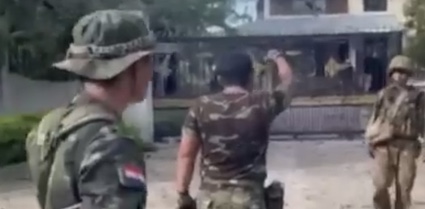Myanmar Military Clashes and Three Brotherhood Alliance (China and India)
Kanako Mita and Lee Jay Walker
Modern Tokyo Times

The military elites in Myanmar are under mounting pressure after many setbacks against the Three Brotherhood Alliance. Accordingly, border areas between China and Myanmar and India and Myanmar – in many areas – are now under the control of non-central forces.
Ethnic conflicts and religious dimensions within the body politic of various forces opposed to the Myanmar military elites are nothing new. After all, authoritarianism and the role of the military in crushing internal political dissent are decades old.
State Counselor Aung San Suu Kyi provided a window of opportunity for Myanmar to follow the democratic path. However, her arrest – and the crushing of her political party and opposition forces to the military elites – are unraveling against the ruling elites with the growth of the Three Brotherhood Alliance and the People’s Defense Force (PDF).
The BBC reports, “Locally-formed militias across the vast, mountainous state came together under the umbrella of the Chin Defence Force and began to acquire modern weapons from over the border in India.”
This ethnic group is mainly Christian. Hence, with tensions in parts of Northeast India between Christians and Hindus, authorities in India will be worried about the changing situation on the ground.
Concerning the border with China, Voice of America reports, “Conflict in Shan State, in the northeast bordering China, has displaced at least 50,000 people, with trade routes cut off and several towns seized since an anti-junta offensive launched last month by three ethnic minority insurgent groups.”
The number displaced is growing each new day – some estimate that over 200,000 people have fled areas of recent military fighting.
Reuters reports, “The military, which seized power from an elected government in a 2021 coup, is battling a coordinated offensive launched last month by an alliance of three ethnic minority insurgent groups, as well as allied pro-democracy fighters who have taken up arms since the coup.”
AP reports, “The Arakan Army launched surprise assaults on two outposts of the Border Guard Police, a paramilitary force, in Rakhine’s Rathedaung township, according to independent online media and area residents. The attacks took place despite a yearlong cease-fire with Myanmar’s military government.”
Myanmar central forces under the military have been rocked by the Three Brotherhood Alliance consisting of the Myanmar National Democratic Alliance Army, the Arakan Army, and the Ta’ang National Liberation Army (TNLA) – along with the PDF and improvised drone warfare – which are collectively upping the ante against the state apparatus of Myanmar.
The role of China is murky. After all, political elites in China have good relations with the military leadership of Myanmar and various ethnic groups opposed to central forces along the border.
Myanmar is set for continuing bloodshed, economic hardship, and increasing power concentration policies by an array of anti-government forces.
In the past, the armed forces of Myanmar could concentrate forces against countless ethnic groups and internal dissent – even if not controlling the nation-state throughout the country. However, under the prevailing conditions, the military looks overstretched – irrespective of counter-attacks developing.
Aung San Suu Kyi is the only individual who could break the cycle of increased violence. However, the military elites that opened the can of worms appear unable to alter course.
Also- opposition forces (political and ethnic) may deem this the right time to overthrow the military leadership – which looks increasingly vulnerable.
The Three Brotherhood Alliance said we are “dedicated to eradicating the oppressive military dictatorship, a shared aspiration of the entire Myanmar population.”
If the military leadership is forced from power, it remains to be seen what the outcome would be.
Will democracy emerge – or will various ethnic groups seek to preserve power concentration that ultimately leads to the disintegration of Myanmar?
In the past, the military crushed potent political forces – and pushed ethnic military groups to limited areas where they were contained. However, the level of political dissent and the militarization of opposition forces – along with drone warfare – is at a new level.
Myanmar is set for more bloodshed and a future that remains unknown.
A new dawn of hope – or disintegration?

Modern Tokyo News is part of the Modern Tokyo Times group
http://moderntokyotimes.com Modern Tokyo Times – International News and Japan News
http://sawakoart.com – Sawako Utsumi’s website and Modern Tokyo Times artist
https://moderntokyonews.com Modern Tokyo News – Tokyo News and International News
PLEASE JOIN ON TWITTER
https://twitter.com/MTT_News Modern Tokyo Times
PLEASE JOIN ON FACEBOOK